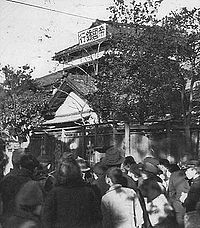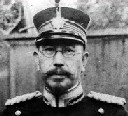“War is within all men, regardless of their politics, regardless of their religion, regardless of their nationality, regardless of their race. It is the abyss beneath all our skins, the abyss within all our skulls. And once we have looked into that abyss…we are no longer human, we are only war, are only murder, only death.”
In this hea rt-thumping experimental novel which bursts the bounds of the usual genre categories, British author David Peace creates an impressionistic story of a real Tokyo bank robbery and the deaths of twelve bank employees on January 26, 1948. A man representing himself as a doctor investigating a case of potentially fatal dysentery in the neighborhood appears at the Shiina-Machi branch of the Teikoku Bank just after closing time. He says he must inoculate all the employees in the bank against this disease, and decontaminate all the documents and money that an infected man may have touched. He explains how he will give each person two different medicines and shows them how to roll up their tongues for the first liquid so that the medicine will not hurt their teeth or gums. After one minute, he gives them all the second liquid. Two minutes after that, sixteen victims, writhing in agony, have fallen unconscious, and twelve of them die, poisoned with cyanide. The physician then removes the day’s receipts and disappears.
rt-thumping experimental novel which bursts the bounds of the usual genre categories, British author David Peace creates an impressionistic story of a real Tokyo bank robbery and the deaths of twelve bank employees on January 26, 1948. A man representing himself as a doctor investigating a case of potentially fatal dysentery in the neighborhood appears at the Shiina-Machi branch of the Teikoku Bank just after closing time. He says he must inoculate all the employees in the bank against this disease, and decontaminate all the documents and money that an infected man may have touched. He explains how he will give each person two different medicines and shows them how to roll up their tongues for the first liquid so that the medicine will not hurt their teeth or gums. After one minute, he gives them all the second liquid. Two minutes after that, sixteen victims, writhing in agony, have fallen unconscious, and twelve of them die, poisoned with cyanide. The physician then removes the day’s receipts and disappears.

As detectives investigate those who might have had access to cyanide, they follow a lead and pursue an artist who uses cyanide in making tempura paints–a man who already has a history of fraud. The man is arrested and jailed, though a witness has stated unequivocally that he is not the killer. Further investigation of this crime becomes an entree into the author’s wide-ranging study of Japan’s use of biological warfare in Manchuria, before and during World War II. Cyanide was the subject of much research and experimentation there, and Pingfan Army Unit 731, the chemical lab unit, did extensive experiments, fully described, under Gen. Shiro Ishii. Any one of the Pingfan soldiers could have committed these murders, though Gen. Ishii himself “loses his memory” about what happened in Pingfan when interviewed by the Soviets and the Americans after the war. Who was really responsible for the cyanide poisoning in the bank becomes a big question in the followup to the biological weapons investigation. Further investigation shows that officials on all sides colluded in a coverup about biological weapons programs, and even the newspapers and reporters were complicit.
The author uses a Rash omon-like structure for the novel, featuring twelve different narrators who provide information about the crime in the manner of a traditional Japanese ghost-story-telling game. This game begins with the “shadows” of twelve narrators lighting candles together–a detective, a female survivor, an American physician, a practitioner of the occult who lives in a shrine, a journalist, a businessman/yakuza gangster, a Soviet investigator of war crimes, the man convicted of the murder, and others. Each tells his own horror story regarding the bank robbery, after which he blows out his candle, creating a darker and darker atmosphere for successive “Candles.” When the final narrator blows out his candle, the participants are sitting in blackness, waiting for ghouls to appear and the abyss to open.
omon-like structure for the novel, featuring twelve different narrators who provide information about the crime in the manner of a traditional Japanese ghost-story-telling game. This game begins with the “shadows” of twelve narrators lighting candles together–a detective, a female survivor, an American physician, a practitioner of the occult who lives in a shrine, a journalist, a businessman/yakuza gangster, a Soviet investigator of war crimes, the man convicted of the murder, and others. Each tells his own horror story regarding the bank robbery, after which he blows out his candle, creating a darker and darker atmosphere for successive “Candles.” When the final narrator blows out his candle, the participants are sitting in blackness, waiting for ghouls to appear and the abyss to open.
These characters all provide journals, notebooks, newspaper articles, police reports, letters, and individual testimony to build an archival record of the real story, which attest to the author’s comprehensive research during the many years he lived in Tokyo. Despite the full background material, however, the novel is by no means straightforward or journalistic. Instead, the author creates swirling images of the Occupation of Japan, developing kaleidoscopic impressions which change at warp speed. The novel’s pace is driven by its language, which twists and turns in upon itself, echoes, and repeats phrases in parallels–more like music than prose in its style and emotional intensity.
 Sometimes the novel feels like a long canon, or “round,” while at other times one can only think of a grand operatic chorus. Sometimes four or five different speakers reveal information simultaneously (often within the same sentence). Each speaks as if in a soliloquy, talking over the other characters and interrupting their sentences to include their own thoughts. It is a uniquely powerful technique which requires the reader’s “willing suspension of literary expectations,” and it can be both exhilarating and challenging. The author does not always distinguish between his real people and his ghostly shadows, and often a reader may be unsure who is speaking during these long “canons.” A remarkable section described as The Ninth Candle (“The Thirty-Six Wounds of a Second Detective”) contains“five acts” within the section–far more an opera than a play. The cumulative effect of this complex technique may frustrate those who are just looking for a good mystery but will delight those who enjoy clever literary techniques and a broad thematic scope.
Sometimes the novel feels like a long canon, or “round,” while at other times one can only think of a grand operatic chorus. Sometimes four or five different speakers reveal information simultaneously (often within the same sentence). Each speaks as if in a soliloquy, talking over the other characters and interrupting their sentences to include their own thoughts. It is a uniquely powerful technique which requires the reader’s “willing suspension of literary expectations,” and it can be both exhilarating and challenging. The author does not always distinguish between his real people and his ghostly shadows, and often a reader may be unsure who is speaking during these long “canons.” A remarkable section described as The Ninth Candle (“The Thirty-Six Wounds of a Second Detective”) contains“five acts” within the section–far more an opera than a play. The cumulative effect of this complex technique may frustrate those who are just looking for a good mystery but will delight those who enjoy clever literary techniques and a broad thematic scope.
Notes: The author’s photo by David Sillitoe appears on www.serpentstail.com, which announces David Peace’s selection as GQ Writer of the Year in 2007.
The photo which shows the crowds gathered outside the Teikoku Bank in the aftermath of the killings appears on http://en.wikipedia.org
Gen. Shiro Ishii’s photo appears on www.sonicbomb.com
In an interview in The Scotsman, the author declares that after this book, which is his tenth, he will write only two more books. Then he will retire. http://thescotsman.scotsman.com
